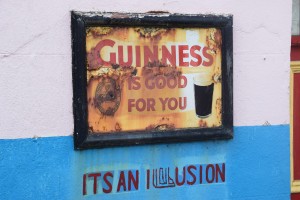
Most people drink some alcohol in their lifetime. In 2013, 87% of adults reported drinking alcohol at some point in their life, 71% drank in the past year and 56% drank in the past month (Substance Abuse and Mental Health Services Administration, 2013).
In addition, 25% of adults reported binge drinking in the past month and 7% reported heavy drinking in the past month. The economic, social and health burden of alcohol-related problems are well known, with 17.6 million adults meeting criteria for a past-year alcohol-use disorder in 2004 (Grant et al, 2007) and alcohol misuse costing the US $223.5 billion (Centers for Disease Control and Prevention, 2006).
However, few individuals receive treatment for their alcohol problems, despite the availability of interventions that are cost-effective and improve relevant clinical outcomes (Dawson et al, 2005; Zarkin et al, 2010). Brief interventions for alcohol use present an opportunity to identify alcohol problems, offer brief advice and encourage individuals to cut down on their drinking in various medical settings (Babor et al, 2007).
To address the full spectrum of alcohol use problems (including heavy alcohol use, severe problems etc.) Screening, Brief Intervention and Referral to Treatment (SBIRT) programmes focus on referring individuals to treatment. Whilst reviews and meta-analyses have demonstrated the effectiveness of brief alcohol interventions in reducing alcohol use (Kaner et al, 2009; Whitlock et al, 2004), few have examined the ability of SBRIT programmes to improve the use of alcohol-related treatment. In one review, the efficacy of SBIRT in adolescent drinkers was unable to identify any randomised controlled trials (RCTs) that assessed referral to treatment (Mitchell et al, 2013). Similarly, reviews of SBI have not provided sufficient data to inform the referral to treatment part process in SBIRT. In general, reviews have not provided adequate evidence to determine whether brief alcohol interventions increase subsequent treatment use.
The present study aimed to evaluate the extent to which RCTs of brief alcohol interventions are effective in referring individuals to alcohol treatment services.

This meta-analysis focused on patients who are not seeking help for their unhealthy alcohol use.
Methods
Database search
MEDLINE, PsychINFO and CINAHL Databases were searched for peer-reviewed articles that were published up to 26 July 2013. A hand search was performed on references of the included studies, SBIRT bibliographies and relevant papers.
Inclusion criteria
Included studies were:
- Randomised Controlled Trials (RCTs) of alcohol brief intervention
- Studies that intervened with unhealthy alcohol use in medical settings
- Conducted with non-treatment seeking drinkers
- Interventions that had linkage to alcohol-related services assessed as intervention outcome or as a mediator of intervention outcomes
- Published in the English language
Included studies were not restricted by modality of referral process to treatment. Also, inclusion of studies was not specific to any particular country.
Exclusion criteria
Excluded studies were:
- Those with participants who used drugs other than alcohol
- Those with a study outcome of attendance at treatment sessions as part of a research study
- Those that evaluated the integration of addiction treatment into general healthcare settings (As findings may not generalise to programmes with differing transition practices and organisational resources)
Primary outcome
The primary outcome was post-intervention use of alcohol services measured by self-report or administration data in intervention versus control groups.
Study characteristics
Studies were grouped according to age (adolescent or adult). Data were extracted on intervention setting (medical in-patient, general healthcare, emergency department). Interventions were classified as low (no in-person contact), medium (single session) or high intensity (multiple sessions). Severity of alcohol use was categorised as high (alcohol dependent, recently detoxified, severe alcohol-induced medical problems), low (non-dependent) or mixed (dependent, problem and risky/heavy drinkers).
Data analysis and risk of bias
Risk ratios (RR) and 95% confidence intervals (CI) were calculated in models with random effects. Subgroup analyses with performed on study characteristics (age, setting, intervention intensity, alcohol use severity).
Risk of bias was assessed by; randomisation concealment, participants lost to follow-up, standardisation of intervention delivery, presence of intention to treat analysis. Publication bias was assessed via analysis of systematic bias in reporting.
Results
Study characteristics
13 independent RCTs of alcohol brief interventions that assessed post-intervention alcohol treatment use met inclusion criteria. 4 RCT were conducted outside of the US in Australia, Germany, Poland and France
The majority of interventions involved brief advice or a motivational interview. Several interventions also offered additional counselling or booster intervention sessions and one intervention offered no in-person contact, where a letter was sent asking the patient to make an appointment with the specialist.
Post-intervention referral
5 of the 13 studies did not describe any referral specific processes for the intervention group.
In total 6 of the 8 studies with specific referral processes isolated these processes to the intervention group only. The 2 further studies provided information about treatment options as the referral component, for both intervention and control groups.
Alcohol-related care
In 11 of 13 studies treatment use was defined as attendance at one or more sessions of addiction treatment. The remaining 2 studies analysed counts of speciality addiction treatment visits.
4 studies used administrative data and the rest used self-report to evaluate treatment utilisation. Only 2 studies used validated measures of self-report. Follow-up ranged from 3-18 months, with one study reporting a 10 year follow-up.
Only one study found a significant different between intervention and control groups in the use of alcohol treatment.
Studies with the high-severity samples tended to have higher post-intervention use of treatment in the intervention group. Studies conducted in the emergency departments and/or with mixed-severity samples had a lower range of post-intervention treatment use in the intervention group.
Alcohol-related outcomes
9 out of 13 studies reported improvements in one or more drinking outcomes due to brief interventions at one or more time-points.
2 studies analysed the association between alcohol treatment use and alcohol-related outcomes. One study showed SBI was associated with a reduction in drink-driving, alcohol-related injuries, moving violations and alcohol-related problems, with a small study sample. The other concluded that the effects of SBI on alcohol consumption was not due to receiving alcohol treatment.
Bias
Only one study reported adequate randomisation. Additionally, the only study to report a significant effect on treatment use was identified as high-risk for bias. There was no evidence of publication bias.
Meta-analysis outcomes
10 studies had sufficient data for meta-analysis, however the study with high-risk of bias was removed before analysis.
In these 9 studies (n = 993 intervention, n = 937 control group) the random effects pooled risk ratio (RR) was=1.08, 95% confidence interval (CI) = 0.92 to 1.28, indicating no significant effect.
Other subgroup analyses of studies with common characteristics (e.g. age, setting, severity, risk of bias) also yielded non-statistically significant results.

Brief alcohol interventions did not help people who are not seeking help to recognise their condition and decided to do something about it.
Conclusions
Results indicate no evidence that brief interventions for alcohol use are effective in increasing the use of alcohol-related treatment.
Samples with higher alcohol severity and/or patients recruited from in-patient medical settings tended to have higher use of alcohol treatment services. The authors suggest that this finding indicates that severity-stratified analyses may be the most valid method for evaluating treatment referral.
However, a subgroup meta-analysis found that regardless of alcohol severity, intervention setting and intervention intensity, brief interventions were not efficacious in improving alcohol treatment utilisation. The authors caution that the number of studies in each subgroup was small and that a greater number of studies would increase the power to examine subgroup effects.
No studies analysed the association between treatment utilisation and clinical outcomes. Therefore, it remains unknown whether referral to and use of alcohol treatment leads to improved clinical outcomes.
Finally, there was a diverse range of patient severity and intervention content in the evaluated studies. The authors suggest that services for low and high severity patients should be evaluated systematically for referring each of these groups.

The barriers to treatment are high for heavy drinkers who are not seeking help.
Reflections
Few studies have examined the utilisation of alcohol treatment following SBI. The included studies were limited in their description of the referral process, indicating the need for better reporting in clinical trials examining SBIs and SBIRTs. Similarly, the assessment of alcohol-related treatment varied across studies and in some instances was not adequately described to enable the type of care to be determined or assessed.
Referral of patients to higher level alcohol treatment is an important component of SBIRT programmes. Despite support from public health in the implementation of SBIRT as a form of addressing a range of alcohol-related problems, there is a lack of evidence to suggest that brief alcohol interventions have any efficacy for increasing the uptake of alcohol-related services.
Finally, the main finding of this study is in contrast to the commonly held assumption that SBI or SBIRT treatment referral effectively links patients to further treatment for their alcohol-related problem. However, before dismissing SBIRT, we must acknowledge the limitations of RCTs studying SBIRTs, which have not adequately focused on referral to treatment. Future clinical trials should use referral as a primary study outcome and appropriately track alcohol treatment utilisation.

We still struggle to identify people with substance use disorders and improve their health.
Links
Primary paper
Glass JE, Hamilton AM, Powell BJ, Perron BE, Brown RT, Ilgen MA. Specialty substance use disorder services following brief alcohol intervention: a meta-analysis of randomized controlled trials. Addiction. 2015 Sep;110(9):1404-15. doi: 10.1111/add.12950. Epub 2015 Jun 3. [PubMed abstract]
Other references
Babor, T.F. et al (2007) Screening, brief intervention and referral to treatment (SBIRT): toward a public health approach to the management of substance abuse. Substance Abuse: 28: 7-30. [PubMed abstract]
Centers for Disease Control and Prevention. Excessive drinking costs U.S. $223.5 billion. Available at: http://www.cdc.gov/features/alcoholconsumption/
Dawson, D.A. et al (2005) Recovery from DSM-IV alcohol dependence: United States. Addiction: 101: 281-92.[PubMed abstract]
Grant, B.F. et al (2004) Prevalence and co-occurrence of substance use disorders: results from the National Epidemiologic Survey on alcohol and related conditions. Archives of General Psychiatry: 61:807-16. [PubMed abstract]
Kaner, E.F. et al (2009) The effectiveness of brief alcohol interventions in primary care settings: A systematic review: Drug and Alcohol Review: 28:301-23. [PubMed abstract]
Substance Abuse and Mental Health Services Administration (SAMHSA). 2013 National Survey on Drug Use and Health (NSDUH). Table 2.41B—Alcohol Use in Lifetime, Past Year, and Past Month among Persons Aged 18 or Older, by Demographic Characteristics: Percentages, 2012 and 2013. Available at: http://www.samhsa.gov/data/sites/default/files/NSDUH-DetTabsPDFWHTML2013/Web/HTML/NSDUH-DetTabsSect2peTabs1to42-2013.htm#tab2.41b
Zarkin, G.A. et al (2010) The effects of alcohol treatment on social costs of alcohol dependence: results from the COMBINE study. Medical Care: 48:396-401. [PubMed abstract]


Screening, Brief Intervention and Referral to Treatment (SBIRT) https://t.co/vvztx9WiD4 #MentalHealth https://t.co/2wpuAamaUe
RT iVivekMisra Screening, Brief Intervention and Referral to Treatment (SBIRT) https://t.co/fhi45FYS72 #MentalHea… https://t.co/z1vpSpRkp3
Today I blog for @Mental_Elf on Screening, Brief Intervention and Referral to Treatment (SBIRT) https://t.co/x168QKsjaw via sharethis
@SallyScientist @Mental_Elf timely blog given the @NuffieldTrust #alcohol report
Today @SallyScientist on specialty substance use disorder services following brief alcohol intervention https://t.co/SuyCPREUH6
Screening, Brief Intervention and Referral to Treatment (SBIRT) https://t.co/QmU7LYMzqw
#Screening, Brief #Intervention & Referral to #Treatment (SBIRT) https://t.co/UwaOch5rK5 #evidence from a #RCT #alcohol #alcoholabuse
brief interventions for alcohol not effective in increasing use of alcohol treatments by @SallyScientist @Mental_Elf https://t.co/oYk13TwfVh
Brief interventions don’t seem to lead to people taking up alcohol treatment (when they might benefit from it).
https://t.co/gm96kVEiiL
Brief alcohol interventions didn’t help ppl not seeking help to recognise their condition & do something about it https://t.co/SuyCPREUH6
@Mental_Elf you have to intervene when they are not drunk, but intervening when they are sober has not effect other than justifying a drink!
Las intervenciones breves en problemas de alcohol no ayudan a las personas que no están buscando ayuda https://t.co/WcOAJw5XaO
New study finds no evidence that brief interventions are effective at increasing use of alcohol-related treatment https://t.co/SuyCPREUH6
Don’t miss: Screening, Brief Intervention and Referral to Treatment (SBIRT) https://t.co/SuyCPREUH6 #EBP
[…] http://www.nationalelfservice.net/mental-health/substance-misuse/screening-brief-intervention-and-re… […]
[…] 1Screening, Brief Intervention and Referral to Treatment (SBIRT) […]
[…] fellow Elf, Sally Adams, outlined the original Screening, Brief Intervention and Referral to Treatment SBIRT) report in a blog last year (Adams […]